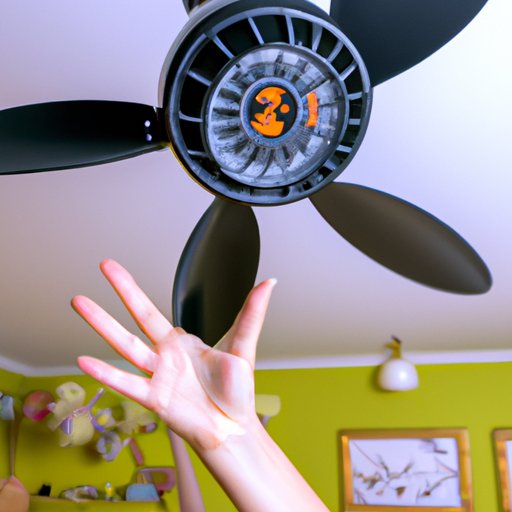Introduction
Installing a ceiling fan is a great way to add style and comfort to your home. Before you can install the fan, however, it is important to measure the space correctly to ensure that the fan will fit properly. This article will provide a comprehensive guide on how to measure for a ceiling fan.
Research the Size of the Room and Select an Appropriate Fan
Before you start measuring for your fan, it is important to research the size of the room and select an appropriate fan. The size of the fan should be based on the size of the room and the amount of air circulation needed. Generally, larger rooms require larger fans while smaller rooms are better suited for smaller fans. Additionally, the shape of the room should also be taken into consideration when selecting a fan. For example, a room with a high ceiling may need a fan with a longer downrod to reach the desired height.

Measure the Height of the Ceiling
Once you have selected the fan, you must measure the height of the ceiling. This is important because it will determine the length of the downrod needed for the fan. Downrods are available in various lengths, so it is important to measure the height of the ceiling accurately.
Establish the Length of Downrod Required
The length of the downrod should be determined based on the height of the ceiling and the desired height of the fan. Generally, the downrod should be at least 12 inches (30 cm) in length. However, if the ceiling is higher than 8 feet (2.4 m), then a longer downrod may be required. If the fan is being installed on a sloped ceiling, then the length of the downrod should be adjusted accordingly.

Calculate the Distance from the Floor to the Blades of the Fan
Once the length of the downrod has been established, the next step is to calculate the distance from the floor to the blades of the fan. To do this, measure the distance from the floor to the center of the fan using a tape measure. Then add the length of the downrod to this measurement. This will give you the total height of the fan from the floor.

Determine the Clearance Needed from the Blades to the Walls and Other Obstacles
It is important to make sure that there is enough clearance between the fan blades and walls or other obstacles. The general rule of thumb is to have a minimum of 18 inches (45 cm) of clearance from the blades to any wall or obstacle. However, this may vary depending on the size of the fan.
Decide on the Type of Mount Needed to Install the Fan
There are several different types of mounts that can be used to install a ceiling fan. These include flush mounts, standard mounts, and angled mounts. Flush mounts are ideal for ceilings that are 8 feet (2.4 m) or lower, while standard mounts are suitable for ceilings up to 12 feet (3.6 m). Angled mounts are best for ceilings that are higher than 12 feet (3.6 m).

Measure the Width of the Fan to Ensure it Fits in the Desired Location
Before installing the fan, you should also measure the width of the fan to ensure that it fits in the desired location. This is especially important if there are any obstacles in the way such as light fixtures or furniture. You should also measure the distance between the fan and the ceiling to make sure that it is properly secured.
Conclusion
Measuring for a ceiling fan is an important part of the installation process. In order to ensure that the fan fits properly and is secure, it is essential to measure the size of the room, the height of the ceiling, the distance from the floor to the blades of the fan, the clearance needed from the blades to the walls and other obstacles, the type of mount needed to install the fan, and the width of the fan. Following these steps will help you to successfully measure for a ceiling fan.


